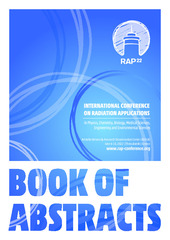Приказ основних података о документу
Beryllium-7 activity concentration trends in Serbia and Slovenia
| dc.creator | Bianchi, Stefano | |
| dc.creator | Plastino, Wolfango | |
| dc.creator | Rajačić, Milica | |
| dc.creator | Krneta Nikolić, Jelena | |
| dc.creator | Todorović, Dragana | |
| dc.creator | Zorko, Benjamin | |
| dc.creator | Nečemer, Marijan | |
| dc.creator | Vodenik, Branko | |
| dc.creator | Glavič Cindro, Denis | |
| dc.creator | Kožar Logar, Jasmina | |
| dc.creator | Sarvan, Darko | |
| dc.creator | Đurđević, Vladimir | |
| dc.creator | Ajtić, Jelena | |
| dc.date.accessioned | 2022-08-30T07:44:23Z | |
| dc.date.available | 2022-08-30T07:44:23Z | |
| dc.date.issued | 2022 | |
| dc.identifier.isbn | 978-86-81652-04-6 | |
| dc.identifier.uri | https://vet-erinar.vet.bg.ac.rs/handle/123456789/2479 | |
| dc.description.abstract | Beryllium-7 is a natural radionuclide used as a tracer of the stratospheric-tropospheric exchange. Its abundance in the surface air is expected to change as the temperatures in the atmosphere increase. To investigate the temporal trends of the beryllium-7 activity concentrations and temperature, we apply spectral analysis to time series from three sampling sites: Belgrade in Serbia, and Ljubljana and Krško in Slovenia. The sites lie close to the 45 ºN parallel, with Krško approximately 400 km and Ljubljana around 500 km west of Belgrade. Between January 1991 and December 2019, the air filter samples were collected using air samplers; a monthly composite sample was formed and analysed by gamma spectrometry. We use monthly mean temperature records from the European Climate Assessment & Dataset, the Republic Hydrometeorological Service of Serbia for Belgrade, and the Slovenian Environment Agency for the sites in Slovenia. In the spectral analysis decomposition, we look into a term called trend that represents the overall growth (increase or decrease) in the data records. The trend is calculated using a linear fit. All three sites show 1) positive temperature trends, however statistically insignificant (at the 95 % confidence level), and 2) statistically significant beryllium-7 activity concentration trends of 2.26 %/year, 1.13 %/year, and 0.50 %/year in Belgrade, Ljubljana, and Krško, respectively. The results confirm our initial hypothesis–over the 28 investigated years, the beryllium-7 activity concentrations increase in the surface air. On the other hand, the non-significant temperature rise in our records suggests that within our method, the temporal resolution of one month is insufficient for obtaining a statistically significant temperature trend. | sr |
| dc.language.iso | en | sr |
| dc.publisher | Niš : Sievert Association | sr |
| dc.rights | openAccess | sr |
| dc.source | International conference on radiation applications (RAP 2022) | sr |
| dc.subject | Beryllium-7 | sr |
| dc.subject | Belgrade | sr |
| dc.subject | Ljubljana | sr |
| dc.subject | Krško | sr |
| dc.subject | surface air | sr |
| dc.title | Beryllium-7 activity concentration trends in Serbia and Slovenia | sr |
| dc.type | conferenceObject | sr |
| dc.rights.license | ARR | sr |
| dc.citation.spage | 45 | |
| dc.identifier.fulltext | http://veterinar.vet.bg.ac.rs/bitstream/id/6970/bitstream_6970.pdf | |
| dc.identifier.rcub | https://hdl.handle.net/21.15107/rcub_veterinar_2479 | |
| dc.type.version | publishedVersion | sr |

